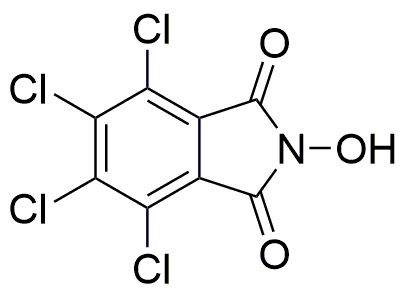N-Hydroxytetrachlorophthalimide is widely utilized in research focused on:
- Water Treatment: This compound serves as an effective biocide in water treatment processes, helping to eliminate harmful microorganisms and improve water quality.
- Agricultural Applications: It is used as a fungicide in agriculture, protecting crops from fungal infections and enhancing yield, particularly in high-value crops.
- Polymer Chemistry: N-Hydroxytetrachlorophthalimide acts as a key intermediate in the synthesis of various polymers, contributing to the development of materials with enhanced properties.
- Analytical Chemistry: This chemical is employed in analytical methods for detecting and quantifying other compounds, making it valuable in quality control processes in laboratories.
- Pharmaceutical Research: It has potential applications in drug formulation, particularly in creating compounds with improved bioavailability and therapeutic efficacy.
General Information
Properties
Safety and Regulations
Applications
N-Hydroxytetrachlorophthalimide is widely utilized in research focused on:
- Water Treatment: This compound serves as an effective biocide in water treatment processes, helping to eliminate harmful microorganisms and improve water quality.
- Agricultural Applications: It is used as a fungicide in agriculture, protecting crops from fungal infections and enhancing yield, particularly in high-value crops.
- Polymer Chemistry: N-Hydroxytetrachlorophthalimide acts as a key intermediate in the synthesis of various polymers, contributing to the development of materials with enhanced properties.
- Analytical Chemistry: This chemical is employed in analytical methods for detecting and quantifying other compounds, making it valuable in quality control processes in laboratories.
- Pharmaceutical Research: It has potential applications in drug formulation, particularly in creating compounds with improved bioavailability and therapeutic efficacy.
Documents
Safety Data Sheets (SDS)
The SDS provides comprehensive safety information on handling, storage, and disposal of the product.
Product Specification (PS)
The PS provides a comprehensive breakdown of the product’s properties, including chemical composition, physical state, purity, and storage requirements. It also details acceptable quality ranges and the product's intended applications.
Certificates of Analysis (COA)
Search for Certificates of Analysis (COA) by entering the products Lot Number. Lot and Batch Numbers can be found on a product’s label following the words ‘Lot’ or ‘Batch’.
Numéro de catalogue
Numéro de lot/série
Certificates Of Origin (COO)
This COO confirms the country where the product was manufactured, and also details the materials and components used in it and whether it is derived from natural, synthetic, or other specific sources. This certificate may be required for customs, trade, and regulatory compliance.
Numéro de catalogue
Numéro de lot/série
Safety Data Sheets (SDS)
The SDS provides comprehensive safety information on handling, storage, and disposal of the product.
DownloadProduct Specification (PS)
The PS provides a comprehensive breakdown of the product’s properties, including chemical composition, physical state, purity, and storage requirements. It also details acceptable quality ranges and the product's intended applications.
DownloadCertificates of Analysis (COA)
Search for Certificates of Analysis (COA) by entering the products Lot Number. Lot and Batch Numbers can be found on a product’s label following the words ‘Lot’ or ‘Batch’.
Numéro de catalogue
Numéro de lot/série
Certificates Of Origin (COO)
This COO confirms the country where the product was manufactured, and also details the materials and components used in it and whether it is derived from natural, synthetic, or other specific sources. This certificate may be required for customs, trade, and regulatory compliance.


